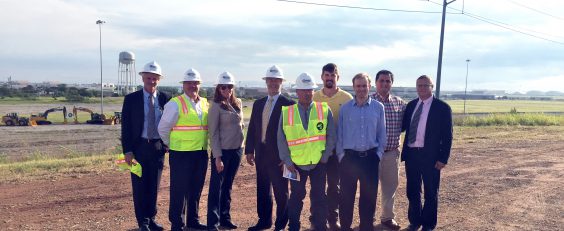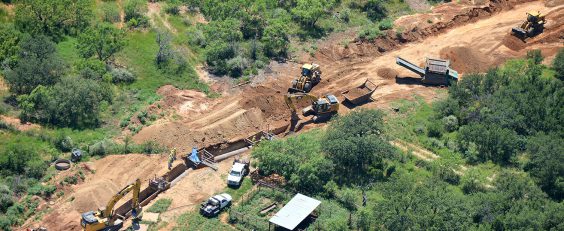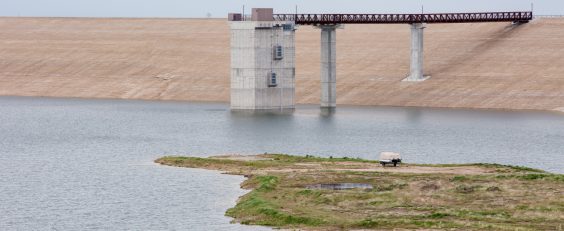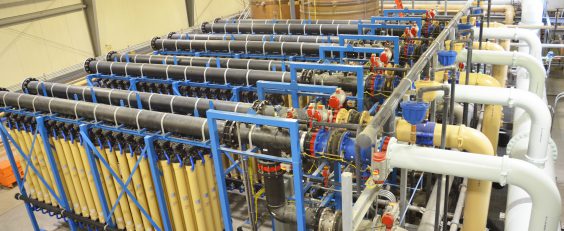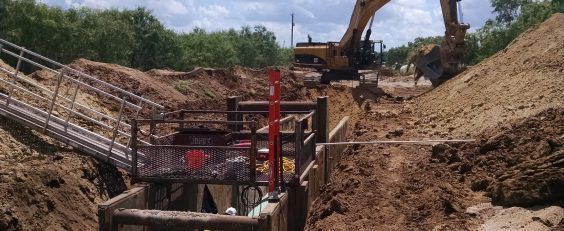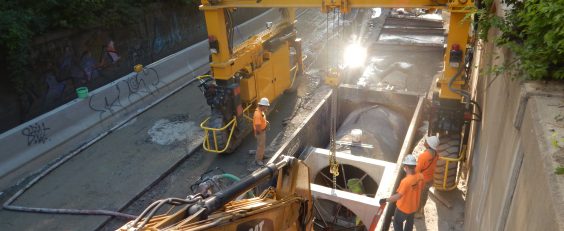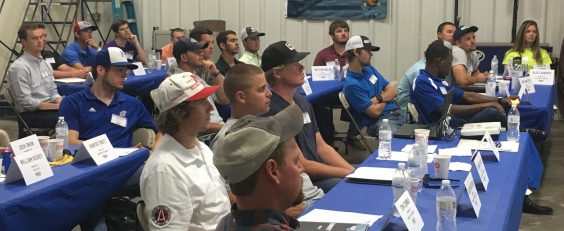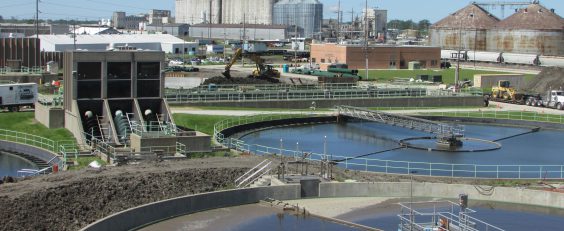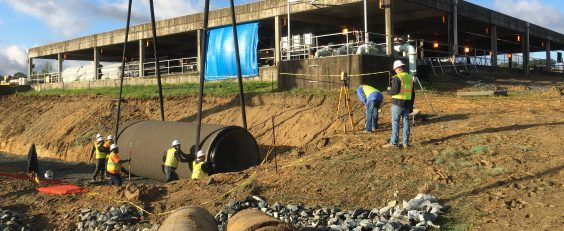Talking Shop with Tim Porter: Driving Future Growth within the Power and Industrial Market
Oct 2016
OCTOBER 2016 – Since joining Garney six months ago, Tim Porter has developed impressive growth within the power and industrial market. Porter joined Garney in April 2016 as Business Development Manager with a sole focus to broaden Garney’s client base in the power and industrial market sector throughout the United States. He brings 27 years of experience in the private sector, primarily within the power market delivering large-scale water supply and related infrastructure. This week, Porter sat down to share insight on the direction of the market and the plan for the future.
With more than 27 years of private and industrial construction expertise, what prompted you to join Garney?
Garney is a national leader in the water resource market. With the power and industrial market on a slow but steady comeback, I saw Garney in a great position to where I could help leverage Garney’s leadership role, national footprint, and established industry relationships within the market sector.
What have you learned at Garney within the past six months that will drive future growth in the private market sector?
As a previous competitor of Garney’s, I was surprised to learn the level of commitment to attracting bright young talent. Combining this with the long-term experienced ‘gray beards’ is a solid package for growth.
One challenge is transitioning some of the relationship capitol of the established individuals so the company can maintain a network of layers with our clients and engineering partners.
How will you leverage Garney’s expertise in water and wastewater infrastructure within this market segment?
We have already begun by bringing young talent to lead complicated power and industrial projects. This exposure will pay dividends for many years to come. It also creates an urgency for managers to share their skills and expertise. The challenge is this requires more time from an already stretched contingency of the company.
From your perspective, what challenges must the power and industrial market overcome with regard to stringent regulations in maintaining existing infrastructure?
The complete lack of a comprehensive energy plan in our country has hindered the power market for nearly all of my career. Regulatory impacts and unrealistic timelines have forced closures of many valuable assets within the coal and nuclear segment prior to the end of their anticipated design life. These types of assets will not be easily rebuilt in a pinch.
Garney stands to benefit from the most recent regulatory assault. The new ELG (Effluent Limitation Guidelines) regulations will prohibit coal-fired power plants from discharging ash related effluent through current permitted outfalls. This in itself creates pipeline and treatment opportunities, but the short deadline creates urgency that will consume all of the capable contractors and vendors’ resources. Garney is working to position ourselves to capitalize on this perfect storm via strong joint venture agreements and building new relationships with Owners.
What is unique about working in the power and industrial market?
The power and industrial markets present tough projects with tight timelines that force contractors to hit the ground running with very little design completed. Contractors who stub their toe early can face crippling damages along with being ostracized in the industry.
What is your strategy for success?
It may sound simple, but I believe in showing up. So many people are content to work through email and long distance communication. It is nearly impossible to build a strong relationship and garner the type of insight necessary to solve a client’s issues from afar. Once you show up, be a resource. There are plenty of vendors who will buy lunch but fail to deliver any value. If you spend time with the client, it is almost impossible not to learn about the business. Once you do that, try to understand what they want before you get to what you want.
Federal Momentum Rises with Groundbreaking at Tinker Air Force Base
Oct 2016
OCTOBER 2016 – Work is officially underway with the groundbreaking of the new KC-46A Tanker Sustainment Campus at Tinker Air Force Base in Oklahoma City, Oklahoma. This future depot maintenance facility will be home to the Air Force’s next-generation aerial refueling aircraft, the KC-46A Pegasus. The Contrack Watts / Garney Federal joint venture will construct $36 million in new utility infrastructure for the depot maintenance facility, including water, wastewater, industrial waste, storm, and dry utilities. This project marks the first of several military construction projects to deliver KC-46 capabilities to Tinker Air Force Base. The KC-46A Pegasus, designed by Boeing, will refuel military aircraft while employing multiple layers of protection to detect and defeat in medium-threat environments.
The 158-acre campus will provide a number of hangars, ramp infrastructure, software innovation labs, and engine test facilities. This facility will benefit the nation’s generations for years to come, and will generate more than 1,300 new jobs for the State of Oklahoma. The Contrack Watts / Garney Federal team anticipates completing construction by spring 2018.
This is a milestone project for Garney Federal. “We are excited to serve our Air Force through this Army Corps of Engineers contract,” said Jay McQuillen, P.E., President of Garney Federal. “Working with our pipe operations and industry partners, we see this as an opportunity to add the Federal customer to Garney’s already successful public client operations. This project will carry us well into 2017, and allow Garney Federal to build Government contracting capabilities.”
Learn more about the KC-46A Tanker Sustainment Campus and how the KC-46A Pegasus tanker will provide security for our nation’s defense.
CMAR Delivery Boosts Water Supply Amid Scarcity in Texas
Oct 2016
OCTOBER 2016 – The year 2014 marked one of the worst droughts in Texas history, driving the City of Abilene, Texas, to initiate the PK Second Stage Drought Strategy project to develop available water sources.
Stage One of the City’s plan, the Hamby Water Reclamation Facility and Indirect Reuse project, was completed in 2015 providing much needed relief to the area. The raw water augmentation from the Hamby project only offset 25 percent of the daily water demands, which was not enough to counteract the historic drought.
Enprotec / Hibbs & Todd, Inc. (eHT) was tasked to develop the design for improvements to use brackish raw water from Possum Kingdom Lake and desalinate the raw water to a sufficient level to match current raw water quality from Hubbard Creek Reservoir. The City’s goals required upgrading the existing Possum Kingdom Lake intake pump station, owned by the Brazos River Authority, installation of 42 miles of raw water, product water and concentrate pipelines, and a raw water roughing facility (RWRF) designed to desalinate raw water prior to final conventional water treatment.
With the City’s objective to start using Possum Kingdom Lake water no later than the summer of 2015, eHT determined Construction Manager at Risk (CMAR) delivery would be vital in meeting the project’s aggressive schedule. Garney was selected as the CMAR through a value-based selection process in late 2014 and worked with eHT to fast-track the schedule. This included purchasing long lead materials and developing subcontracted scopes while final design was underway. Features of this critical project included:
RAW WATER PIPELINE: 48,890 LF of 36-inch C303 bar wrapped pipe, 565 LF of 48-inch steel cased bores, two connections to existing facilities, blow-off and ARV appurtenances
PRODUCT WATER PIPELINE: 36,730 LF of 36-inch C303 bar wrapped pipe, 3,374 LF of 36-inch HDPE horizontal directional drill (HDD), 804 LF of 48-inch steel cased bores, four connections to existing facilities, blow-off and ARV appurtenances
CONCENTRATE PIPELINE: 70,332 LF of 12-inch PVC pipe, 13,300 LF of 14-inch HDPE, 45 HDDs, outfall structure, and ARV appurtenances
Construction of the 36-inch raw water and product water pipelines was completed in November 2015 allowing the transfer of water to the City of Abilene. Today, the City continues to take a leadership role within the region by exploring opportunities with eHT and Garney to conserve available water supply. With water security becoming a growing issue in West Texas, the City remains diligent in determining solutions to provide additional water now, and for future generations to come.
“The City of Abilene is proud to have implemented a second stage short-term drought response strategy that included 30 miles of raw water, product water and concentrate pipelines along with the construction of a Raw Water Roughing Facility designed to partially desalinate raw PK water prior to being sent to Abilene for final, conventional water treatment,” said Tommy O’Brien, Executive Water Utilities Director for the City of Abilene. “Critical challenges that were successfully met include fast-track design and construction of a Reverse Osmosis system.”
Senate Passes Water Resource Development Act
Oct 2016
OCTOBER 2016 – Following years of action by a diverse alliance of water sector organizations, the Water Resources Development Act (WRDA) of 2016 has passed with strong bipartisan support. This is a crucial step to investing in the future of water infrastructure. The bill passed with a 95-3 vote on September 15 and is now pending consideration by the House.
Since the development of this bill, Garney has maintained an active presence in voicing support through local congressional representatives. If passed, this hallmark legislation will authorize new and existing water infrastructure financing through fiscal year 2021. Impactful authorizations and reforms to the bill include:
- Investment in U.S. Army Corps of Engineers water resources and conservation projects including: navigation, flood management, and ecosystem restoration
- Aid in reducing communities’ public health risks and rural drinking water systems
- Development of financing for innovation in water technology
Learn more about the importance of this bill and its potential impact through the Library of Congress.
Garney Water Partnership Helps Left Hand Water District Pilot First Design-Build Project
Jul 2016
JULY 2016 — In an effort to better serve the Left Hand Water District’s (the District) 20,000 customers during summer peak demand, the 8 million gallon per day (MGD) Dodd Water Treatment Plant needed additional capacity. The District selected the Garney Water Partnership, a joint venture between Garney Construction and Burns & McDonnell, to complete the $29 million design-build plant expansion. This project marked the first alternative delivery project for the District. During the value-based selection, Garney Water Partnership was the only team that could meet the District’s aggressive schedule.
“The District was extremely concerned with keeping the project on schedule without compromising quality or rushing decisions,” said Christopher Smith, General Manager of Left Hand Water District. “Through the design-build process, we were able to move forward with pre-purchasing major systems and site excavation, while continuing to focus on the details of our new plant.”
Throughout the project, Garney worked closely with Burns & McDonnell to identify project phasing and value engineering options to meet the schedule and budget. During the design phase, Garney provided design reviews and work packages, in addition to developing the guaranteed maximum price (GMP). Construction commenced once the GMP was established but prior to final design. This approach accelerated the schedule and the start of construction. Garney was able to conduct design reviews throughout final design development, while simultaneously self-performing construction.
“By the time we had a final design, excavation was complete and Garney successfully met an extremely aggressive schedule with the new plant treating water by May 2016,” said Smith.
As a peaking plant for the District, the facility only operates during the summer when water demands increase from farmers and residents within 110 square miles throughout Boulder and Weld counties. The existing plant had to remain in operation until September 2015 and return online by late spring 2016. This limited the construction schedule to a nine month winter shutdown. The demolition and installation of the Pall membranes in the existing plant could not begin until shutdown, leaving no margin for error in coordinating work activities.
The facility, now rated at 16 MGD, is currently in operation providing water to the District’s customers while Garney completes final phases of closeout. Substantial completion was achieved ahead of schedule on May 12, 2016. The project was also completed below budget, which will allow the District to complete additional upgrades at their primary facility.
“We have no doubt that few teams could have met all of our objectives within such a compressed design and construction timeline,” said Smith.
P3 Projects on the Rise
Jul 2016
JULY 2016 — Public-private partnerships, commonly referred to as P3, are growing rapidly in popularity in many states across the country. With limited funding, an increasing number of municipalities are turning to the private sector.
According to the American Society of Civil Engineers (ASCE), upgrading the country’s infrastructure will cost $3.6 billion by 2020. As the nation’s infrastructure continues to decline, P3 is quickly becoming an avenue for state and municipal funding. Legislation in favor of P3 is also on the rise.
Garney is an active supporter of P3 legislation, and recently finalized the takeover of the Vista Ridge Water Supply project. This P3 venture is a significant milestone as Garney will play a lead role in overseeing the design, construction, and financing for a 142-mile raw water system. Vista Ridge will expand San Antonio’s water supply by 20 percent, decreasing pressure on the sensitive Edwards Aquifer, which is subject to Federal, state and regional pumping regulations.
Construction is set to begin early next year and last through 2019, with water flowing by 2020.
“We’re excited to help secure San Antonio’s water future,” said Scott Parrish, Chief Operating Officer for Garney Construction. “Garney has a 30-year history delivering projects for SAWS water ratepayers and we’re here for the next 30 years – you’ve got a company that can get the project to the finish line and secure the water future for this community.”
For more information on P3, visit The National Council for Public for Public-Private Partnerships.
Kansas City to Host ASCE Pipelines
Jul 2016
JULY 2016 – Garney has been a long supporter of the American Society of Civil Engineers (ASCE), the oldest engineering society in the nation. ASCE represents more than 150,000 members of the civil engineering profession in 177 countries, and provides the industry’s leading experts and information through their many conferences. The Pipelines Conference is recognized at the forefront of ASCE’s educational programming, and provides a platform for attendees to discover and exchange ideas related to planning, designing, constructing, and operating these lifeline assets.
Hosted in Kansas City from July 16-20, Pipelines 2016 is part of the new ASCE Utility Engineering & Surveying Institute (UESI). Pipelines will continue to provide a forum for industry constituents from all around the world to share their experiences in meeting the challenges of today’s pipeline infrastructure. Pipelines has become a premier conference for utility and pipeline owners, engineers, contractors, manufacturers, and suppliers. This year, the conference will also include surveying as it relates to pipelines and utility projects.
Garney’s involvement with Pipelines continues to expand. Employee-owners presenting and moderating for the 2016 technical program include:
- Logan CSO Interceptor Installation Beneath an Existing Improved Channel | Jordan Carrier, Presenter
- CMAR Project Delivery Method Facilitates Construction of a Large Diameter Pipeline and Treatment Plant Upgrade Project Allowing Timely Access to Much Needed Water Resources in North Texas | David Burkhart, Presenter
- Design-Build Approach to Major Crossing Avoids Environmental and Third Party Impacts…and Saves $10 Million | Bill Williams, Presenter
- Planning & Design II Track B, Session B4 | Matt Foster, Moderator
- Planning & Design II Track B, Session B9 | Mike Gardner, Moderator
With the conference set in the heartland, Pipelines anticipates attracting the highest number of attendees in history. For more information on the conference visit Pipelines 2016.
The Logan CSO Interceptor Project, featured above, will be presented at Pipelines 2016 by Jordan Carrier, Project Manager for Garney Construction.
Garney Provides Record-Breaking Level of Internships
Jul 2016
JULY 2016 – From 22 different colleges and universities, Garney hired a record-breaking group of 64 interns and co-op students for the summer term. This group is working on project sites nationwide and in several offices alongside project management, estimating, and marketing. During the term, undergraduates receive exposure to Garney’s culture, the employee stock ownership plan (ESOP), and a number of different business functions including safety, scheduling, quality control, estimating, and labor relations.
Garney’s objective is to provide a positive learning experience that allows undergraduates to gain an understanding of the industry as well as Garney’s method of conducting business. The internship program has been a mainstay for Garney for nearly 30 years and falls in line with the company’s consistent growth driven by new opportunities and a strong market.
Many of Garney’s current employee-owners started their careers through the company’s internship program. Garney strives to seek individuals who thrive when given the opportunity to learn and lead, which often translates to hiring directly from our internship program. Interested in building with Garney? Apply online at Garney.com.
Industrial waste processes improved at St. Joseph facility
Apr 2016
APRIL 2016 — The City of St. Joseph, Missouri, has a metropolitan population of 128,000 people. The City and the majority of its surrounding area is served by a single wastewater treatment facility, the Water Protection Facility (WPF). The facility neighbors heavy industrial and food processing plants and is adjacent to the Missouri River, which serves as its discharge location. This secondary treatment facility is currently permitted for an average design flow of 27 million gallons per day (MGD). It is fed domestic, commercial, and industrial wastewater by a separated sewer system on the east side of the City and a combined sewer system on the west side. Additionally, three industrial plants send pre-treated industrial waste directly to the facility.
With ammonia limits becoming more stringent, two studies were commissioned by the City to analyze their processes. First, a facilities plan study, followed by a study to further evaluate improvements to the WPF that would address anticipated ammonia limits. Based on the analysis, the City determined that upgrades would be required to meet future regulatory requirements, such as the need for nitrogen and phosphorus removal. This prompted the Ammonia Removal Improvements, a $50 million project consisting of improving ammonia removal, adding a BioSolids dryer facility, and replacing an aging headworks and grit facility.
Garney is currently serving as the wastewater treatment plant contractor to improve the existing facility to meet initial ammonia limits, while the overall goal is to address future, more stringent, effluent limits for ammonia, total phosphorous, and total nitrogen.
Improvements to the facility consist of separating the industrial and domestic influent flows, creating two trains within the plant. The domestic aeration basins are a BNR A20 process for biological nutrient removal, which were installed in the existing aeration basins. The industrial process is an activated sludge BNR system, featuring a five-stage Bardenpho process. Construction of the industrial aeration basin was a significant undertaking as the existing tank, originally constructed for aerobic digestion, was to be reused. The inside of this tank, approximately the size of a football field, was completely reconstructed and increased in size vertically to allow greater volume and provide sufficient hydraulic head for ammonia removal and future nitrogen removal process.
This two train system allows the large industrial flows to skip treatment at the plant and reduces the need for air, making the system more efficient. Improvements at the facility are set to be completed by August 2016.
City of Greensboro capitalizes on CMAR project delivery
Apr 2016
April 2016 — The City of Greensboro, North Carolina, faced ongoing challenges to maintain existing infrastructure while complying with current and upcoming regulatory requirements. As a result, the City’s Water Resources Department initiated two capital improvement projects to improve treatment operations and meet future regulatory requirements with the Construction Manager at Risk (CMAR) project delivery method.
These projects mark the first time for the City to employ the CMAR delivery method. Critical to the City’s alternative delivery selection was the desire to leverage a collaborative approach and engage a Mentor/Protégé program to increase minority and women owned business (M/WBE) and local participation. Following a qualifications-based process, Garney was selected to serve as the CMAR contractor for the T.Z. Osborne Water Reclamation Facility 56 MGD Upgrade (Package 3).
Package 3, one of four projects planned for the City’s $120 million worth of infrastructure improvements, was the first of two CMAR projects implemented by the City. Garney started working in partnership with the City at the 90% design phase. In addition to developing the GMP during preconstruction, Garney worked with the City to maximize the Mentor/Protégé program and developed work packages to meet the City’s M/WBE goals.
Construction on Package 3 is set to be complete in December of 2017, with diamond cloth filters to be used in the upgrade to the existing conventional media filtration, a new technology available to the industry. Major improvements for the 36-year-old water reclamation facility will include a new chlorine contact tank, chemical system upgrades, renovation of all existing traveling bridge filters, and site-wide stormwater improvements. Garney is also completing work at the site for Packages 1 and 2.

